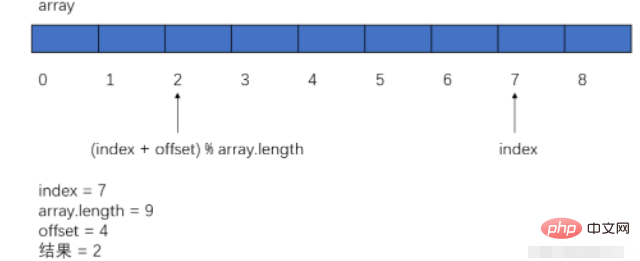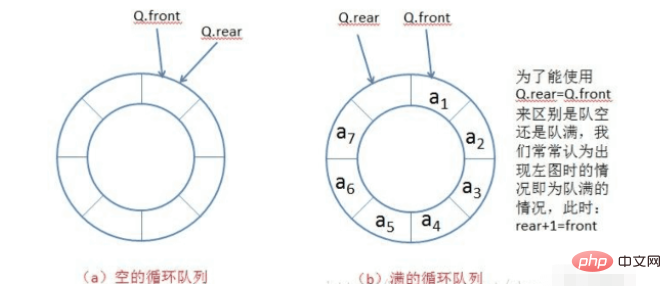Java栈与队列怎么实现
1、实现循环队列
【OJ链接】
循环队列一般通过数组实现。我们需要解决几个问题。
(1)数组下标实现循环
a、下标最后再往后(offset 小于 array.length): index = (index + offset) % array.length。通俗一点,就是如果我们的数组大小为8,下标走到了7,再往后如何回到0,我们可以(index+1)%8来实现。

b、下标最前再往前的时候,我们特殊判断一下,将其置为数组大小减一即可。
(2)区分队列的满与空
我们可以给数组预留一个位置,如果rear+1=front,则表示队列已满;如果rear=front,表示队列为空。这个情况下,我们需要考虑队列大小的问题,在定义数组大小时,需要比原有的大一。

【代码如下】
class MyCircularQueue {
public int front;
public int rear;
public int[] array;
//构造方法
public MyCircularQueue(int k) {
//因为预留位置的缘故,数组的大小要定义为k+1
this.array=new int[k+1];
}
//入队
public boolean enQueue(int value) {
if(isFull()){
return false;
}
this.array[this.rear]=value;
this.rear=(this.rear+1)%this.array.length;
return true;
}
//出队
public boolean deQueue() {
if(isEmpty()){
return false;
}
this.front=(this.front+1)%this.array.length;
return true;
}
//获取队头
public int Front() {
if(isEmpty()){
return -1;
}
return this.array[front];
}
//获取队尾
public int Rear() {
if(isEmpty()){
return -1;
}
int index=-1;
if(this.rear==0){
index=this.array.length-1;
}else{
index=this.rear-1;
}
return this.array[index];
}
//判断是否为空
public boolean isEmpty() {
if(this.front==this.rear){
return true;
}
return false;
}
//判断队列是否满
public boolean isFull() {
if((this.rear+1)%this.array.length==this.front){
return true;
}
return false;
}
}2、队列实现栈
【OJ链接】
因为栈的先进后出、队列的先进先出原则。我们需要两个队列来实现栈。当两个队列都为空时,栈为空。
入栈(push):第一次入栈无所谓,两个队列都为空,随便选择一个队列入队即可;后面入栈时,肯定会有一个队列不为空,找到不为空的队列,进行入队操作。
出栈(pop):首先栈为空时,不能进行出栈操作;栈不为空时,肯定有一个队列为空(queue1),一个队列不为空(queue2),将queue1中的size-1个元素出栈到queue2中(特别注意不能将求queue1大小的函数放进循环里,queue进行出队操作时,其大小是改变的),最后将queue1中最后一个元素进行出队最为返回值。
获取栈顶元素(top):和出栈差不多,就不细说了
【代码如下】
class MyStack {
private Queue<Integer> queue1;
private Queue<Integer> queue2;
//构造方法
public MyStack() {
queue1=new LinkedList<>();
queue2=new LinkedList<>();
}
//入栈
public void push(int x) {
if(!queue2.isEmpty()){
queue2.offer(x);
}else{
queue1.offer(x);
}
}
//出栈
public int pop() {
if(empty()){
return -1;
}
if(queue1.isEmpty()){
int size=queue2.size();
for(int i=0;i<size-1;++i){
int x=queue2.poll();
queue1.offer(x);
}
return queue2.poll();
}else{
int size=queue1.size();
for(int i=0;i<size-1;++i){
int x=queue1.poll();
queue2.offer(x);
}
return queue1.poll();
}
}
//获取栈顶元素
public int top() {
if(empty()){
return -1;
}
if(queue1.isEmpty()){
int x=-1;
int size=queue2.size();
for(int i=0;i<size;++i){
x=queue2.poll();
queue1.offer(x);
}
return x;
}else{
int size=queue1.size();
int x=-1;
for(int i=0;i<size;++i){
x=queue1.poll();
queue2.offer(x);
}
return x;
}
}
//判断栈是否为空
public boolean empty() {
if(queue1.isEmpty()&&queue2.isEmpty()){
return true;
}
return false;
}
}3、栈实现队列
【OJ链接】
还是和上面一样,需要用到两个栈(stack1、stack2)。和实现栈列不同的是,入队只能对同一个栈进行操作。如果两个栈都为空,则队列为空。
入队(push):规定stack1用来入队。每次入队时,对stack1进行入栈操作即可。
出队(pop):规定stack2进行出队操作。如果队列为空时,不能进行出队操作。当stack2为空时,我们需要将stack1中所有元素出栈,放入stack2中,然后对stack2进行出栈操作。如果stack2不为空,则直接对stack2进行出栈操作即可。
获取队列开头元素(peek):和出栈操作相同,最后只需要获取stack2的栈顶元素即可。
【代码如下】
class MyQueue {
private Stack<Integer> stack1;
private Stack<Integer> stack2;
//构造方法
public MyQueue() {
stack1=new Stack<>();
stack2=new Stack<>();
}
//入队操作
public void push(int x) {
stack1.push(x);
}
//出队操作
public int pop() {
if(stack2.empty()){
int size=stack1.size();
for(int i=0;i<size;++i){
int x=stack1.pop();
stack2.push(x);
}
}
return stack2.pop();
}
//获取队列开头的元素
public int peek() {
if(stack2.empty()){
int size=stack1.size();
for(int i=0;i<size;++i){
int x=stack1.pop();
stack2.push(x);
}
}
return stack2.peek();
}
//判断队列是否为空
public boolean empty() {
if(stack1.empty()&&stack2.empty()){
return true;
}
return false;
}
}4、实现最小栈
【OJ链接】
其实就是要在O(1)的时间复杂度内找到栈的最小元素。需要两个栈来实现,一个栈来进行出栈、入栈操作。只需要保证不管如何操作,另一个栈的栈顶元素都是当前栈的最小元素即可。
两个栈stack1、stack2,站的操作都在stack1中:
入栈:如果第一次入栈,我们需要将其也放入stack2中,之后的入栈,将入栈元素与stack2的栈顶元素进行比较,如果其小于stack2的栈顶元素,则将其放入stack2中。
出栈:对stack1出栈时,将其与stack2的栈顶元素进行比较,如果其等于stack2的栈顶元素,则对stack2进行出栈操作。
这样就能保证stack2的栈顶元素总是stack1的最小元素。注意:如果stack1中入栈两个相同的最小元素,都需要对stack2进行入栈。
【代码如下】
class MinStack {
private Stack<Integer> stack1;
private Stack<Integer> stack2;
//构造方法
public MinStack() {
stack1=new Stack<>();
stack2=new Stack<>();
}
//入栈
public void push(int val) {
stack1.push(val);
if(stack2.empty()){
stack2.push(val);
}else{
if(val<=stack2.peek()){
stack2.push(val);
}
}
}
//出栈
public void pop() {
int x=stack1.pop();
if(x==stack2.peek()){
stack2.pop();
}
}
//获取栈顶元素
public int top() {
return stack1.peek();
}
//获取栈的最小元素
public int getMin() {
return stack2.peek();
}
}以上是Java栈与队列怎么实现的详细内容。更多信息请关注PHP中文网其他相关文章!

热AI工具

Undresser.AI Undress
人工智能驱动的应用程序,用于创建逼真的裸体照片

AI Clothes Remover
用于从照片中去除衣服的在线人工智能工具。

Undress AI Tool
免费脱衣服图片

Clothoff.io
AI脱衣机

Video Face Swap
使用我们完全免费的人工智能换脸工具轻松在任何视频中换脸!

热门文章

热工具

记事本++7.3.1
好用且免费的代码编辑器

SublimeText3汉化版
中文版,非常好用

禅工作室 13.0.1
功能强大的PHP集成开发环境

Dreamweaver CS6
视觉化网页开发工具

SublimeText3 Mac版
神级代码编辑软件(SublimeText3)

热门话题
 突破或从Java 8流返回?
Feb 07, 2025 pm 12:09 PM
突破或从Java 8流返回?
Feb 07, 2025 pm 12:09 PM
Java 8引入了Stream API,提供了一种强大且表达力丰富的处理数据集合的方式。然而,使用Stream时,一个常见问题是:如何从forEach操作中中断或返回? 传统循环允许提前中断或返回,但Stream的forEach方法并不直接支持这种方式。本文将解释原因,并探讨在Stream处理系统中实现提前终止的替代方法。 延伸阅读: Java Stream API改进 理解Stream forEach forEach方法是一个终端操作,它对Stream中的每个元素执行一个操作。它的设计意图是处
 Java程序查找胶囊的体积
Feb 07, 2025 am 11:37 AM
Java程序查找胶囊的体积
Feb 07, 2025 am 11:37 AM
胶囊是一种三维几何图形,由一个圆柱体和两端各一个半球体组成。胶囊的体积可以通过将圆柱体的体积和两端半球体的体积相加来计算。本教程将讨论如何使用不同的方法在Java中计算给定胶囊的体积。 胶囊体积公式 胶囊体积的公式如下: 胶囊体积 = 圆柱体体积 两个半球体体积 其中, r: 半球体的半径。 h: 圆柱体的高度(不包括半球体)。 例子 1 输入 半径 = 5 单位 高度 = 10 单位 输出 体积 = 1570.8 立方单位 解释 使用公式计算体积: 体积 = π × r2 × h (4
 创造未来:面向零基础的 Java 编程
Oct 13, 2024 pm 01:32 PM
创造未来:面向零基础的 Java 编程
Oct 13, 2024 pm 01:32 PM
Java是热门编程语言,适合初学者和经验丰富的开发者学习。本教程从基础概念出发,逐步深入讲解高级主题。安装Java开发工具包后,可通过创建简单的“Hello,World!”程序实践编程。理解代码后,使用命令提示符编译并运行程序,控制台上将输出“Hello,World!”。学习Java开启了编程之旅,随着掌握程度加深,可创建更复杂的应用程序。











